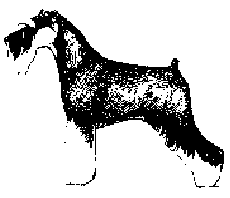Schnauzer (miniature)
A breed standard is the guideline which describes the ideal characteristics, temperament, and appearance of a breed and ensures that the breed is fit for function with soundness essential. Breeders and judges should at all times be careful to avoid obvious conditions and exaggerations, as well as being mindful of features which could be detrimental in any way to the health, welfare or soundness of this breed.
Breed Standard - Schnauzer (miniature)
 General Appearance:
General Appearance: Sturdily built, robust, sinewy, nearly square, (length of body equal to height at shoulders). Expression keen and attitude alert. Correct conformation is of more importance than colour or other purely ‘beauty’ points.
Characteristics: Well balanced, smart, stylish and adaptable.
Temperament: Alert, reliable and intelligent. Primarily a companion dog.
Head and Skull: Head strong and of good length, narrowing from ears to eyes and then gradually forward toward end of nose. Upper part of the head (occiput to the base of forehead) moderately broad between ears. Flat, creaseless forehead; well muscled but not too strongly developed cheeks. Medium stop to accentuate prominent eyebrows. Powerful muzzle ending in a moderately blunt line, with bristly, stubby moustache and chin whiskers. Ridge of nose straight and running almost parallel to extension of forehead. Nose black with wide nostrils. Lips tight but not overlapping.
Eyes: Medium-sized, dark, oval, set forward, with arched bushy eyebrows.
Ears: Neat, V-shaped, set high and dropping forward to temple.
Mouth: Jaws strong with perfect, regular and complete scissor bite, i.e. upper teeth closely overlapping lower teeth and set square to the jaws.
Neck: Moderately long, strong and slightly arched; skin close to throat; neck set cleanly on shoulders.
Forequarters: Shoulders flat and well laid. Forelegs straight viewed from any angle. Muscles smooth and lithe rather than prominent; bone strong, straight and carried well down to feet; elbows close to body and pointing directly backwards.
Body: Chest moderately broad, deep with visible strong breastbone reaching at least to height of elbow rising slightly backward to loins. Back strong and straight, slightly higher at shoulder than at hindquarters, with short, well developed loins. Ribs well sprung. Length of body equal to height from top of withers to ground.
Hindquarters: Thighs slanting and flat but strongly muscled. Hindlegs (upper and lower thighs) at first vertical to the stifle; from stifle to hock, in line with the extension of the upper neck line; from hock, vertical to ground.
Feet: Short, round, cat:like, compact with closely arched toes, dark nails, firm black pads, feet pointing forward.
Tail: Previously customarily docked.
Docked - Set on and carried high, customarily docked to three joints.
Undocked - Set on and carried high, of moderate length to give general balance to the dog. Thick at root and tapering towards the tip, as straight as possible, carried jauntily.
Gait/movement: Free, balanced and vigorous, with good reach in forequarters and good driving power in hindquarters. Topline remains level in action.
Coat: Harsh, wiry and short enough for smartness, dense undercoat. Clean on neck and shoulders, ears and skull. Harsh hair on legs. Furnishings fairly thick but not silky.
Colour: Pepper and salt - shades range from dark iron grey to light grey. Hairs banded dark/light/dark. Dark facial mask to harmonise with corresponding coat colour. Pure Black. Black and silver - solid black with silver markings on eyebrows, muzzle, chest, brisket, forelegs below point of elbow, inside of hindlegs below stifle joint, vent and under tail. White. Good pigmentation essential in all colours.
Size: Ideal height - dogs
36 cms (14 ins); bitches: 33 cms (13 ins). Too small, toyish appearing dogs are not typical and undesirable.
Faults: Any departure from the foregoing points should be considered a fault and the seriousness with which the fault should be regarded should be in exact proportion to its degree and its effect upon the health and welfare of the dog and on the dog’s ability to perform its traditional work.
Note: Male animals should have two apparently normal testicles fully descended into the scrotum.
DNZ No 692
Copyright Dogs New Zealand
26 July 2016
Any departure from the foregoing points should be considered a fault and the seriousness with which the fault should be regarded should be in exact proportion to its degree and its effect upon the health and welfare of the dog and on the dog’s ability to perform its traditional work.




